
 |
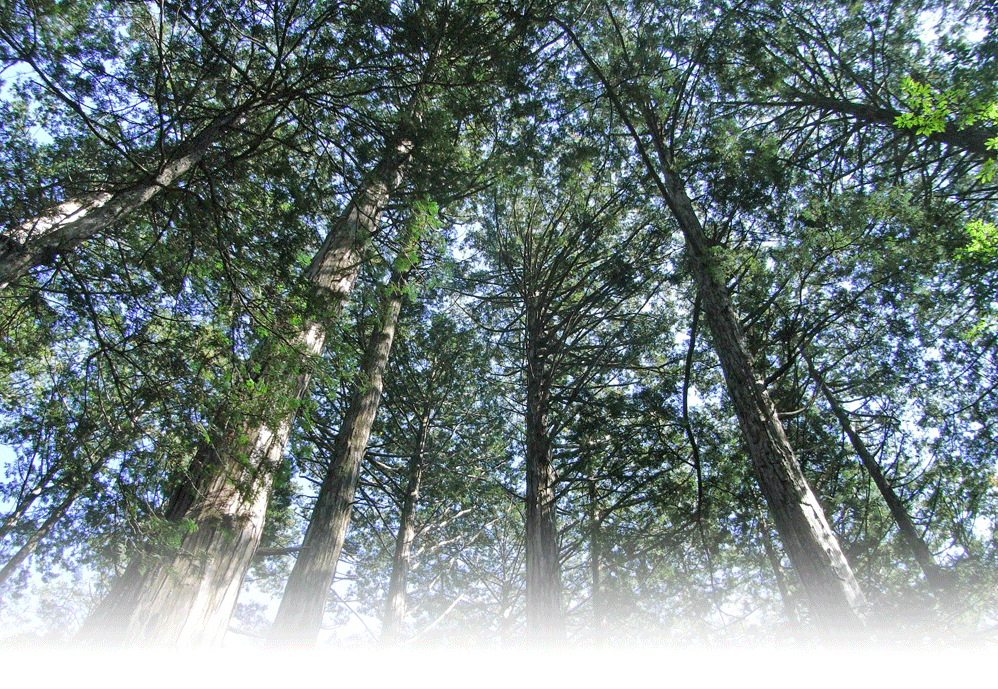
| Overview of Akasawa Natural Recreational Forest The Akasawa Natural Recreational Forest is a coniferous forest, covering the southwest of Agematsu Town. The forest spreads over 728 ha, and varies in elevation from 1,080 m near the parking area, up to 1,558 m. Designated as a National Forest, this region has been spared the planned felling conducted in other areas according to the national forestry policy. Afforded protection by clans in the Edo Era, in the Meiji Era the forest came under the ownership of the imperial family and became the source for wood used in the construction of Ise Shrine. In the post-war period, the forest was designated as a National Forest, a protection that continues to this day. In 1970, the area was opened at the country’s first ‘natural recreational forest’, and saw nationally proposed forest events held for the first time in 1982. The Kiso Forest Railway began operating in 1987. An average of 100,000 people visit the forest each year. The opening period extends from April’s Golden Week public holidays, up until early November, with the opening of the park scheduled for April 29th each year and usually closing on November 7th. The park officially closes for winter between November and April, but there are no gates or other physical barriers to entry. Please note, however, that water sources are unavailable due to freezing, and snowfall can reach depths of around 1.5 m. To access Akasawa Natural Recreational Forest travel west from Agematsu station for about 15 km on prefectural road, Route 473. It takes about 30 minutes on the dedicated bus. The Forest Railway is in operation during the forest’s opening period; however, the service is suspended for scheduled track maintenance a few times each year. Please see the Forest Railway Schedule for more information. |
 |
Access to Akasawa Natural Recreational Forest
|
Highlights of each course
The Akasawa Natural Recreational Forest has a variety of walking trails.
| Fureai (Friendship) Path – 2.8 km return trip. The length of the Fureai (Friendship) Path has been paved and features wooden bridges, allowing wheelchair users and visitors who are less confident on their legs to freely enjoy the forest bathing experience. Only this course forms a return trip on the same path. From Akasawa Bridge & Forest Classroom Square follow the mountain stream uphill heading toward the Maruyamado Terminal. There are many rest areas at various places along the path and guide boards with information about the forest have been installed, making a relaxed way to experience the forest. It should be noted that the Maruyamado Terminal does not have a ticket booth. Visitors wishing to board the Forest Railway should do so from the Forest Railway Platform. The Forest Railway also has a carriage that allows wheelchair access (roll on/off). |
|
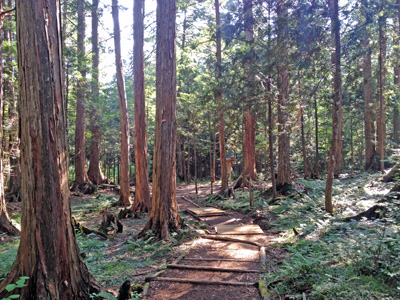 |
Komadori (Robin) Course – 2.7 km circuit The Komadori Course, accessed via the Fureai Path, is the main course leading through scenery and landscapes typical of Akasawa. Walk along the Fureai Path from Akasawa Bridge, branching off at Maruba Bridge. Continue past the “Ise Shrine Sacred Tree Felling Site” and the mountain stream rest area “Dondonbuchi” Pool. Dondonbuchi has toilet facilities and is the best place to take a rest. You are likely to see a number of visitors enjoying a casual picnic lunch here. The course then passes the Giant Hinoki Cypress and Sawarakubo before returning to Tokosegi. The Giant Hinoki Cypress and Giant Sawara Cypress at Sawarakubo stand as the two largest trees in the park. Branches at various points along the path allow visitors to walk this course in combination with other forest courses. |
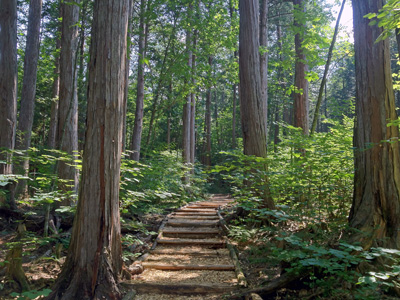 |
Mukaiyama Course – 2.0 km circuit The Mukaiyama Course allows walkers to enjoy scenes of “running roots” of cypress trees freely intertwining, alongside distant views of the Central Alps’ Mt. Kisokomagatake and Mt. Norikura. In mid-June, you can also enjoy the blooms of Magnolia sieboldii flowers. Cross the Akasawa Bridge and enter the footpath straight ahead. On clear days, you can enjoy distant views of Mt. Norikura from the Miharashi Viewpoint, and of Mt. Kisokomagatake from Hirasawa Viewpoint. The trail follows a mountain stream from the Hirasawa Bridge, through a mass of Magnolia sieboldii plants, before returning to the Nakadachi Bridge. |
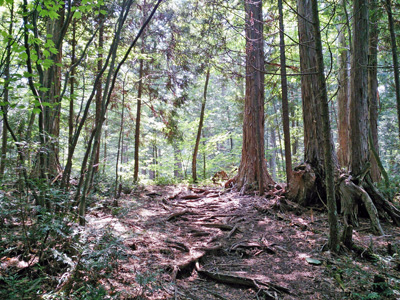 |
Nakadachi Course – 2.1 km circuit The Nakadachi Course is a route that allows walkers to observe the indigenous hinoki, sawara, and hiba cypresses. The path climbs up to the Nakadachi Viewpoint, From there the path back is downhill. Take the left branch at the information board soon after entering the forest from the Nakadachi Bridge. From there climb up to the Nakadachi Viewpoint, along the way you can see the forest of hinoki cypress transforming to that of hiba cypress and rare mother trees of hiba cypress. Heading downhill from Nakadachi Viewpoint brings you back to the Maruba Bridge. Along this section, as the ground becomes more moisture rich, you can observe the increasing distribution of sawara cypresses. |
 |
Tsumetazawa Course – 3.3 km circuit Of all routes in the Akasawa area, the Tsumetazawa Course allows visitors to walk deepest into the forest, enjoying stunning views of Kiso cypress trees. The course is located in the depths of the park area, accessed via the Fureai Path. Proceed on the Fureai Path as far as the Maruyamado Terminal, and from there, walk alongside the tracks of the Forest Railway towards Hontani Bridge. After crossing the bridge, the course becomes a path over a pass to Sawarakubo. At the highest point of the Tsumetazawa Pass, the hinoki cypress trees are considered large, even by the standards of the Recreational Forest. Additionally, in late April, flowers bloom like stars scattered at our feet. From Sawarakubo the route joins the Komadori Course, returning to the park at Tokosegi. |
| Kami-Akasawa Course – 2.2 km circuit The Kami-Akasawa Course lets visitors appreciate the contrast between natural and plantation forests, in addition to enjoying views of Mt. Ontake. From the parking lot, follow the path in front of Resthouse Akasawa, walking trail the Barbeque House before the path doubles back to enter the forest. This area is an artificially maintained, plantation forest, as you can see from the arranged layout of the trees. From the top of the pass there is also a path climbing up to the Akasawa Viewpoint, from where you can enjoy views of Mt. Ontake. Descending from the summit on the section of the course leading to Sawarakubo, it is possible to observe the appearance of a natural forest and see a number of the few varieties of broad leafed trees that grow in the park. From Sawarakubo, the route returns along the same paths as the Komadori Course and the Fureai Path. It is a course that features large changes over the seasons in addition to the changes in landscape along its route. |
|
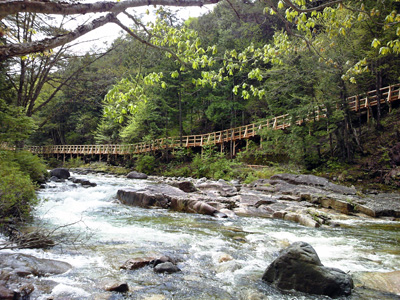 |
Keiryu (mountain stream) Course – 1.5 km circuit The Keiryu Course is a cool forest path where you can enjoy the sounds of mountain streams while you walk. After crossing the Akasawa Bridge, take the promenade leading off to the right. The course follows a mountain stream with no branching paths. Especially in summer, the moisture evaporating from the ground produces a cooler than usual breeze. The course eventually merges with the roadway for the offices of the Kiso Forest Management Station. It is currently the shortest course, but connects to a promenade leading 3km downstream to the Himemiya Bridge allowing visitors to enjoy further walking beside the mountain stream. |
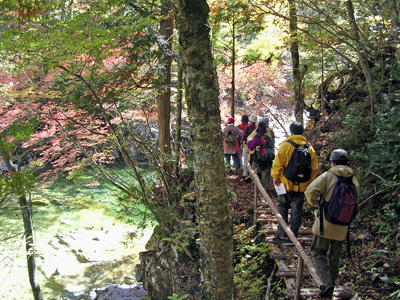 |
Keiryu (mountain stream) Course, Himemiya Route – 3.5 km one-way Extending 3.5 km downstream from Akasawa’s parking lot, this is a walking trail that follows a mountain stream. Since it is a single path, a return trip must be made, either by retracing the path on foot or by walking one way and using a bus the other (there is a bus stop). Please note that the scale of the course differs from the other courses (as printed in the pamphlet). The banks of the mountain stream are, even within Akasawa, considered to convey a rich sense of the seasons, and visitors can enjoy sights such as the Rhododendron dilatatum flowers around the opening of the park or the emerald green river with the vivid orange leaves during fall foliage season. |
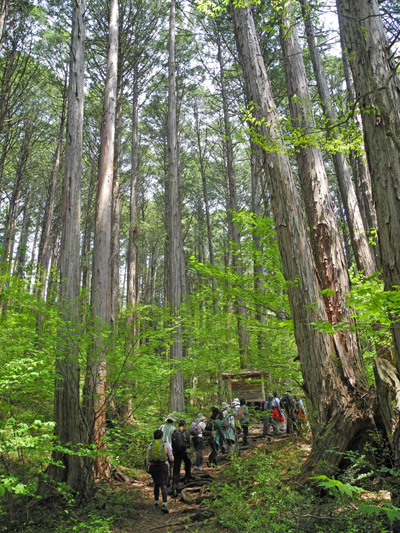 |
Gakujutsu Kenkyu-ro (Academic Research Path) – Restricted Route This is a special area, managed for the genetic protection of the natural Kiso cypress forest and large diameter trees. It is not open for tourism, and is generally only accessible when accompanied by a guide during the Akasawa Forest Bathing, or a member of staff from the Forest Management Department, and is restricted to those carrying out academic research. Information on Akasawa Natural Recreational Forest’s Forest Bathing Events can be found here. |
Guide to facilities within Akasawa Natural Recreational Forest
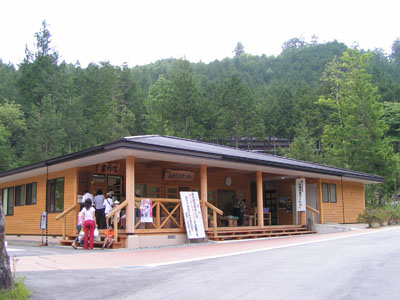 Akasawa Forest Information Center Toilets (men/women/disabled),Seminar Room,Wood-crafted Goods Shop Information on the Summer Vacation Nature Experience Period, Sales Operations |
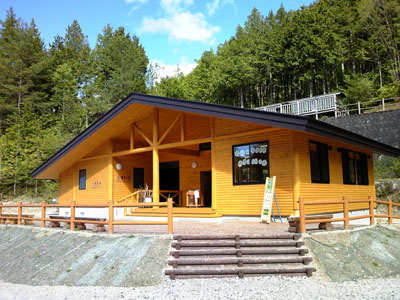 Akasawa Therapy Experience Center Toilets (men/women/disabled w/ ostomate facilities & baby change), Break Room,Forest Doctor Health Consultancy Room,Guide’s Office |
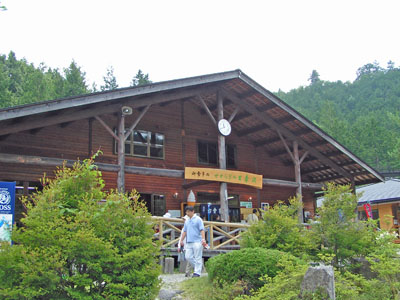 Restaurant “Seseragi-no-Sato Akasawa” TEL:0264-52-2792 (Park Opening Period) Closed on Tuesdays, except during peak season. Rice,Noodles,Magnolia Seiboldii Soft-serve Ice-cream Toilets (men/women/baby change),Souvenir Shop |
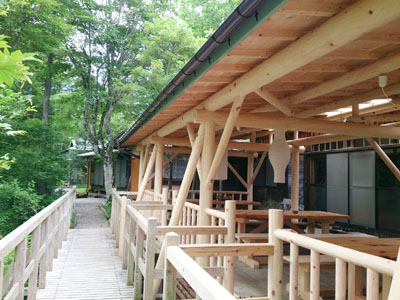 Family-run lodge Kyoraiso TEL:0264-52-2602 (Park Opening Period) Established 1924,By Imperial Appointment Offers a relaxing and luxurious time for adults. |
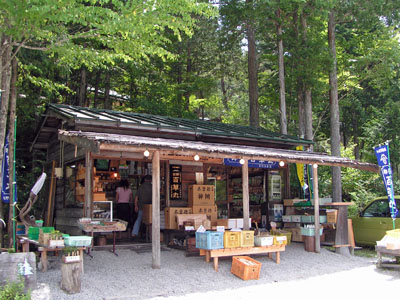 Ki-no-ie Horikawa Wood-crafted specialty product shop, Hyakuso (herbal medicine) re-seller |
 Barbeque House TEL:0264-52-2245 (Within Nezame Hotel) Barbeque,Rice,Gohei-mochi (skewered rice cakes),Salt-grilled Trout Catching fish by hand experience (Summer Vacation Period) |
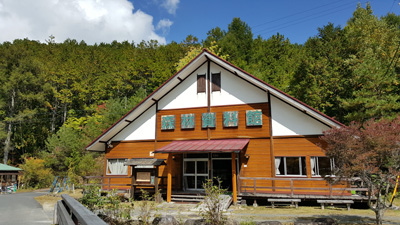 Forest Museum Open during park hours, free entry Exhibits on topics such as forestry history, craftsmanship tools, forest ecology, and ‘The Five Trees of Kiso’. |
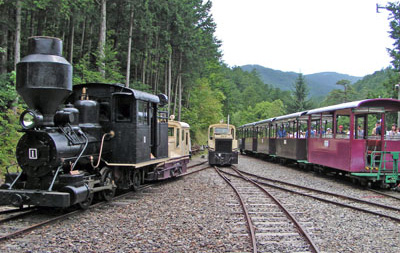 Forest Railway Memorial Museum Open during park hours, free entry See actual forest railway vehicles alongside documentation and exhibits on the railway’s history. Adjacent to the Forest Railway ticket gate and waiting room |
The History of Kiso’s Natural Forests
| The Kiso region’s beautiful cypress forests are naturally renewed, but they are not original virgin forests. There are a very few areas untouched by the human hands, but the majority of the forests that you can walk through today have had their precious existence nurtured by humans over the course of history. Let’s look back at the history of natural Kiso cypress forests, including the Akasawa Natural Recreational Forest. Since ancient times, the Kiso region has been known for producing high quality cypress timber. Starting from the 8th to 12th centuries, it was used to make masks and statues of Buddha, then in the construction of shrines and temples, later becoming a valuable material for the building of castles in the age of the Samurai. The cold conditions in the Kiso Valley means that trees growing here do so in small increments, forming densely packed tree rings over time. Because of this, a piece of Kiso timber of a given diameter is much tougher and more durable than its equivalent from other regions. The powers of the time, desiring timbers such as cypress to construct stronger buildings and castles, focused their efforts on controlling and directly administrating the Kiso region. However, even as the warring states period came to an end, ushering in an era of peace, castle towns continued to grow and develop. The building boom of the early Edo era saw Kiso’s lumber supply depleted, and a growing crisis around forest resources. At this time, the governing clan established a timber office in Kiso, placing the land under direct control and introducing strict forest protection policies. Local residents were forbidden from even entering the forest, let alone felling trees. Breaking the prohibition resulted in a punishment known as “One tree, One head”. Other coniferous species such as zelcova and katsura were subject to similar protections as those covering cypress. These representative conifers came to be known as the “Kiso Goboku” or “Five Trees of Kiso”. The five trees refer to hinoki cypress (Chamaecyparis obtusa), sawara cypress (Chamaecyparis pisifera), nezuko cypress (Thuja standishii), hiba cypress (Thujopsis dolabrata), and koyamaki (Japanese Umbrella Pine, Sciadopitys verticillata) species. While residents suffered under the authorities’ strict forest protections, the forest itself began on the slow path to recovery. By the start of the Meiji era, the beautiful cypress forest had returned, being selected as the forest from which to source the timber for construction at Ise Shrine. Following the World War II, the region became designated as a National Forest and the formerly devastated Akasawa area was miraculously spared any further felling. In 1970, Akasawa was designated as the nation’s first Natural Recreation Forest, reaping the benefits of these new, state-owned woodlands, created with the aim of promoting co-existence between people and the forest. |
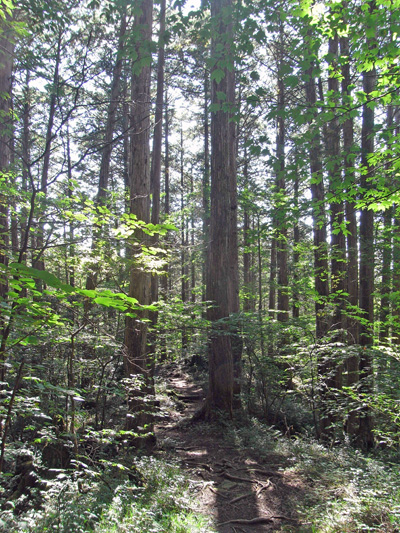 |
|
Key Episodes in the History of Kiso’s Forests 1300s – The forest is managed under the domain of the Kiso clan. 1708 – A felling ban is placed on all conifers, including hinoki cypress 1869 – Placed under the administration of the Imperial Forestry Bureau 1945 – World War II ends and the forest comes under the management of the state forestry department 1950 – Akasawa National Forest is established as a protected forest for academic reference 1969 – Akasawa enters the first stage of designation as a Natural Recreation Forest 1970 – Akasawa Natural Recreational Forest is officially opened |
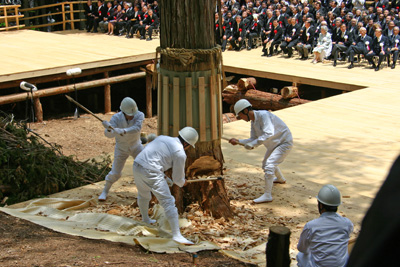 |
Proceed to Part 2 concerning the Forest Railway Or, skip to Part 3 focusing on Forest Bathing.![]()
